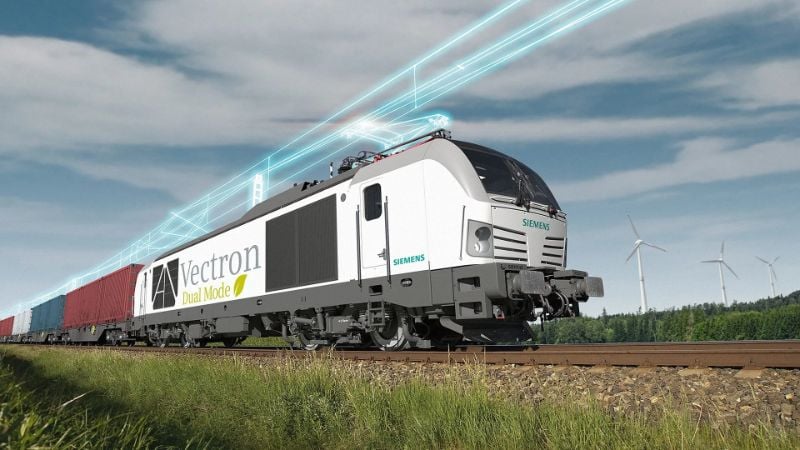No Power Lines? No Problem With Dual-Mode Locomotive
Siemens has introduced Vectron Dual Mode Light to enhance rail efficiency, sustainability, speed, and digitalization.
Due to the dispersed nature of customer locations and resource opportunities, freight locomotives play a crucial role in transporting goods across vast distances. However, their reliance on diesel engines poses environmental challenges due to pollutants and greenhouse gas emissions. The growing need to transition to sustainable energy necessitates integrating alternative power sources to drive freight locomotives.
Siemens Mobility has released its new generation of dual-mode locomotives incorporating diesel and electric drive capabilities.
Dual-mode locomotive. Image used courtesy of Siemens
Current Challenges Electrifying Locomotives
Rail transport is a significant transportation mode in international freight, but, unfortunately, it is also one of the most energy-intensive. Studies indicate rail transport accounts for 2.2% of global transport energy usage and roughly 0.6% of worldwide energy consumption.
Major parts of a railway catenary system. Image used courtesy of Jiang et al.
One potential solution is electrifying locomotive freights using overhead lines. Overhead lines, called catenary systems, employ suspended wires above railway tracks to supply electric power to trains, commonly using alternating current (AC). They are prevalent in mainline and high-speed rail networks and offer the advantage of efficiently transmitting high-voltage power, typically at 25,000 volts AC, over long distances.
However, their complete implementation (throughout the train’s route) is cost-intensive. Electrifying the locomotives necessitates extensive modifications to railway infrastructure, including adjustments to bridges, tunnels, and other structures for wire clearance. Additionally, overhead lines are prone to weather-related disruptions such as strong winds and snowfall in areas with harsh weather, necessitating regular maintenance to uphold reliability.
Balancing operational efficiency with environmental concerns poses a dilemma for rail operators in diverse geographic settings.
Siemens Mobility's Hybrid All Rounder
Siemens Mobility introduces a new era in rail transportation with the debut of the Vectron Dual Mode light locomotive. According to Siemens, the locomotive premiered with DB Cargo to make their fleet more efficient for future operations.
Siemens’ dual-mode locomotive integrates electric and diesel propulsion to offer flexibility in freight operations. The locomotive's dual-mode feature allows it to transition to electric propulsion when an overhead line is accessible and revert to fuel-powered operation when the overhead line is unavailable. The device includes a 950 kW diesel engine system, a 15 k V voltage system, and a maximum electric mode traction power of 2,210 kW. With maximum speeds of 120 km/h and a weight of 84 tons, the solution reduces weight for enhanced efficiency.
The Vectron Dual Mode at a glance. Image used courtesy of Siemens Mobility
With the Vectron Dual Mode, DB Cargo can achieve a nearly carbon-free supply chain by leveraging renewable electricity and alternative fuels (HVO diesel from cooking oils). Specifically, these locomotives help reduce emissions by 25,000 tons of carbon dioxide per year and lower fuel requirements by 12 million liters per year.
Decarbonization Solutions on Track
The initial locomotives will operate in Halle (Saale), with DB Cargo aiming to outfit approximately 70% of its diesel locomotives with advanced drives by 2030. With its dual-mode capability and optimized design, these locomotives offer DB Cargo and its customers enhanced flexibility, reduced emissions, and substantial fuel savings. The future looks promising as these locomotives pave the way for more sustainable supply chains and contribute to mitigating climate change.









